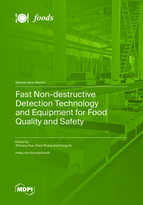Fast Non-destructive Detection Technology and Equipment for Food Quality and Safety
A special issue of Foods (ISSN 2304-8158). This special issue belongs to the section "Food Analytical Methods".
Deadline for manuscript submissions: closed (31 July 2023) | Viewed by 38053
Special Issue Editors
Interests: nondestructive detection of food quality and safety; optical sensing and automation for food quality evaluation; advanced chemometrics methods
Special Issues, Collections and Topics in MDPI journals
Interests: crop phenotype; smart orchard; intelligent agriculture
Special Issues, Collections and Topics in MDPI journals
Special Issue Information
Dear Colleagues,
Fast non-destructive detection technology and equipment for food quality and safety is a powerful technical support tool to ensure the development of food industry informatization and intelligence, with the advantages of fast speed, convenient operation, and easy online inspection. During the past two decades, those technologies have found numerous successful applications for food and agricultural product detection and processing. Owing to improvements in the manufacture of photoelectric sensor pieces and progress in artificial intelligence and software algorithms, fast nondestructive detection technologies provide more accurate, reliable, and stable solutions for food quality and safety detection and processing. They are closely integrated with the Internet of Things and intelligent manufacturing, promoting a new wave of innovation in intelligent manufacturing in the food industry. The application of new sensing technology and equipment in fast nondestructive detection of food has always been at the forefront of scientific and technological research. This issue aims to focus on the latest research progress of the application and jointly discuss the focus of development of this research direction.
Prof. Dr. Zhiming Guo
Prof. Dr. Zhao Zhang
Dr. Dong Hu
Guest Editors
Manuscript Submission Information
Manuscripts should be submitted online at www.mdpi.com by registering and logging in to this website. Once you are registered, click here to go to the submission form. Manuscripts can be submitted until the deadline. All submissions that pass pre-check are peer-reviewed. Accepted papers will be published continuously in the journal (as soon as accepted) and will be listed together on the special issue website. Research articles, review articles as well as short communications are invited. For planned papers, a title and short abstract (about 100 words) can be sent to the Editorial Office for announcement on this website.
Submitted manuscripts should not have been published previously, nor be under consideration for publication elsewhere (except conference proceedings papers). All manuscripts are thoroughly refereed through a single-blind peer-review process. A guide for authors and other relevant information for submission of manuscripts is available on the Instructions for Authors page. Foods is an international peer-reviewed open access semimonthly journal published by MDPI.
Please visit the Instructions for Authors page before submitting a manuscript. The Article Processing Charge (APC) for publication in this open access journal is 2900 CHF (Swiss Francs). Submitted papers should be well formatted and use good English. Authors may use MDPI's English editing service prior to publication or during author revisions.
Keywords
- machine vision
- near infrared spectroscopy
- surface-enhanced raman spectroscopy
- spectral imaging
- gas sensor
- biosensor
- electrochemical sensor
- artificial intelligence
- deep learning
- food Internet of Things









